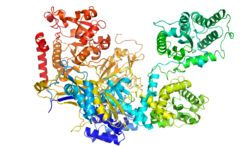Biology:UGGT
| UDP-Glucose Glycoprotein Glucosyltransferase | |
|---|---|
 | |
| Identifiers | |
| Symbol | UGGT |
| UniProt | G0SB58 |
| Other data | |
| Locus | Chr. 2 {{{Arm}}}{{{Band}}}{{{LocusSupplementaryData}}} |
UGGT, or UDP-glucose:glycoprotein glucosyltransferase, is a soluble enzyme resident in the lumen of the endoplasmic reticulum (ER).[1]
The main function of UGGT is to recognize misfolded glycoproteins and transfer a glucose (Glc) monomer (monoglucosylate) to the terminal mannose of the A-branch of the glycan on the glycoprotein. It uses UDP-glucose (UDP-Glc) as the glucosyl donor and requires calcium ions for its activity:
misfolded-glycoprotein-Asn-GlcNAc2Man9 + UDP-Glc => misfolded-glycoprotein-Asn-GlcNAc2Man9Glc1 + UDP
UGGT is about 170 kDa and it consists of two structurally independent portions: a variable N-terminal portion of ~1200 amino acids, which in turn comprises 4 thioredoxin-like domains and two beta-sandwich domains, and senses glycoprotein misfolding; and a highly conserved C-terminal catalytic portion of ~300 amino acids, folding as a glucosyltransferase domain belonging to fold family GT24. Higher eukaryotes possess two isoforms, UGGT1 and UGGT2, but only in 2020 the latter was conclusively shown to be active in misfolded glycoprotein recognition [2]
UGGT is part of the ER quality control system of glycoprotein folding and its activity increases the potential for correctly folded glycoproteins.[3] The main proteins involved in the ER quality control system are UGGT, the ER lectin chaperones (calnexin and calreticulin), and glucosidase II. UGGT first recognizes the incompletely folded glycoprotein and monoglucosylates it. The lectins, calnexin and calreticulin, have high affinities for monoglucosylated proteins and the ER chaperones that associate with these lectins assist the folding of the misfolded glycoprotein. Subsequently, glucosidase II will deglucosylate the glycoprotein. If the glycoprotein is still misfolded, UGGT will re-glucosylate it and allow it to go through the cycle again.
Currently, it is unclear how UGGT recognizes misfolded glycoprotein. It has been proposed that UGGT may bind to exposed hydrophobic stretches, a characteristic feature of misfolded proteins. UGGT crystal structures[4] and Molecular Dynamics simulations[5] suggest marked conformational mobility, which could explain the ability of the protein to recognise a wide variety of client glycoproteins of different shapes and forms. The same conformational mobility could account for the ability of the protein to re-glucosylate N-linked glycans at different distances from the misfold site. See for example the picture in which glycoproteins are symbolized by nuts and UGGT by an adjustable wrench.

References
- ↑ "UDP-Glucose: Glycoprotein Glucosyltransferase 1,2 (UGGT1,2)". Handbook of Glycosyltransferases and Related Genes. Japan, Tokyo: Springer. 2014. pp. 15–30. doi:10.1007/978-4-431-54240-7_107. ISBN 978-4-431-54240-7.
- ↑ "Quantitative glycoproteomics reveals cellular substrate selectivity of the ER protein quality control sensors UGGT1 and UGGT2". eLife 9. December 2020. doi:10.7554/eLife.63997. PMID 33320095.
- ↑ "The ER glycoprotein quality control system". Current Issues in Molecular Biology 6 (1): 29–42. January 2004. PMID 14632257.
- ↑ "Interdomain conformational flexibility underpins the activity of UGGT, the eukaryotic glycoprotein secretion checkpoint". Proceedings of the National Academy of Sciences of the United States of America 114 (32): 8544–8549. August 2017. doi:10.1073/pnas.1703682114. PMID 28739903. Bibcode: 2017PNAS..114.8544R.
- ↑ "Clamping, bending, and twisting inter-domain motions in the misfold-recognizing portion of UDP-glucose:glycoprotein glucosyltransferase". Structure 29 (4): 357–370.e9. December 2020. doi:10.1016/j.str.2020.11.017. PMID 33352114.
 |

